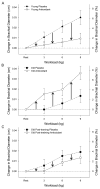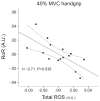Regulation of exercise blood flow: Role of free radicals
- PMID: 26876648
- PMCID: PMC4975999
- DOI: 10.1016/j.freeradbiomed.2016.01.017
Regulation of exercise blood flow: Role of free radicals
Abstract
During exercise, oxygen and nutrient rich blood must be delivered to the active skeletal muscle, heart, skin, and brain through the complex and highly regulated integration of central and peripheral hemodynamic factors. Indeed, even minor alterations in blood flow to these organs have profound consequences on exercise capacity by modifying the development of fatigue. Therefore, the fine-tuning of blood flow is critical for optimal physical performance. At the level of the peripheral circulation, blood flow is regulated by a balance between the mechanisms responsible for vasodilation and vasoconstriction. Once thought of as toxic by-products of in vivo chemistry, free radicals are now recognized as important signaling molecules that exert potent vasoactive responses that are dependent upon the underlying balance between oxidation-reduction reactions or redox balance. Under normal healthy conditions with low levels of oxidative stress, free radicals promote vasodilation, which is attenuated with exogenous antioxidant administration. Conversely, with advancing age and disease where background oxidative stress is elevated, an exercise-induced increase in free radicals can further shift the redox balance to a pro-oxidant state, impairing vasodilation and attenuating blood flow. Under these conditions, exogenous antioxidants improve vasodilatory capacity and augment blood flow by restoring an "optimal" redox balance. Interestingly, while the active skeletal muscle, heart, skin, and brain all have unique functions during exercise, the mechanisms by which free radicals contribute to the regulation of blood flow is remarkably preserved across each of these varied target organs.
Keywords: Antioxidant; Hyperemia; Oxidative stress; Redox balance; Vascular function; Vasodilation.
Published by Elsevier Inc.
Figures










Similar articles
-
Exercise-induced brachial artery vasodilation: role of free radicals.Am J Physiol Heart Circ Physiol. 2007 Mar;292(3):H1516-22. doi: 10.1152/ajpheart.01045.2006. Epub 2006 Nov 17. Am J Physiol Heart Circ Physiol. 2007. PMID: 17114239
-
Regulation of coronary blood flow during exercise.Physiol Rev. 2008 Jul;88(3):1009-86. doi: 10.1152/physrev.00045.2006. Physiol Rev. 2008. PMID: 18626066 Review.
-
Adrenergic and non-adrenergic control of active skeletal muscle blood flow: implications for blood pressure regulation during exercise.Auton Neurosci. 2015 Mar;188:24-31. doi: 10.1016/j.autneu.2014.10.010. Epub 2014 Oct 22. Auton Neurosci. 2015. PMID: 25467222 Review.
-
Exercise in a hot environment: the skin circulation.Scand J Med Sci Sports. 2010 Oct;20 Suppl 3:29-39. doi: 10.1111/j.1600-0838.2010.01206.x. Scand J Med Sci Sports. 2010. PMID: 21029188 Review.
-
Exercise, free radicals and oxidative stress.Biochem Soc Trans. 2002 Apr;30(2):280-5. Biochem Soc Trans. 2002. PMID: 12023865 Review.
Cited by
-
Analysis of the relationship between tuberculosis-related mortality and nitrous oxide emission levels in the world with the environmental Kuznets curve method.Turk J Med Sci. 2022 Aug;52(4):1329-1335. doi: 10.55730/1300-0144.5439. Epub 2022 Aug 10. Turk J Med Sci. 2022. PMID: 36326361 Free PMC article.
-
Acute L-Citrulline Supplementation Increases Nitric Oxide Bioavailability but Not Inspiratory Muscle Oxygenation and Respiratory Performance.Nutrients. 2021 Sep 22;13(10):3311. doi: 10.3390/nu13103311. Nutrients. 2021. PMID: 34684312 Free PMC article. Clinical Trial.
-
Fruit-Derived Polyphenol Supplementation for Athlete Recovery and Performance.Sports Med. 2019 Feb;49(Suppl 1):3-23. doi: 10.1007/s40279-018-0998-x. Sports Med. 2019. PMID: 30671906 Free PMC article. Review.
-
Exercise-Induced Central Fatigue: Biomarkers and Non-Medicinal Interventions.Aging Dis. 2024 Jun 27;16(3):1302-1315. doi: 10.14336/AD.2024.0567. Aging Dis. 2024. PMID: 39012671 Free PMC article. Review.
-
Shexiang Tongxin Dripping Pills regulates SOD/TNF-α/IL-6 pathway to inhibit inflammation and oxidative stress to improve myocardial ischemia-reperfusion injury in mice.Front Cardiovasc Med. 2025 Jun 12;12:1571925. doi: 10.3389/fcvm.2025.1571925. eCollection 2025. Front Cardiovasc Med. 2025. PMID: 40574818 Free PMC article.
References
-
- Furchgott RF, Zawadzki JV. The obligatory role of endothelial cells in the relaxation of arterial smooth muscle by acetylcholine. Nature. 1980;288:373–376. - PubMed
-
- Fisslthaler B, Popp R, Kiss L, Potente M, Harder DR, Fleming I, Busse R. Cytochrome P450 2C is an EDHF synthase in coronary arteries. Nature. 1999;401:493–497. - PubMed
-
- Gonzalez-Alonso J, Olsen DB, Saltin B. Erythrocyte and the Regulation of Human Skeletal Muscle Blood Flow and Oxygen Delivery: Role of Circulating ATP. Circ Res. 2002;91:1046–1055. - PubMed
Publication types
MeSH terms
Substances
Grants and funding
LinkOut - more resources
Full Text Sources
Other Literature Sources
Medical

